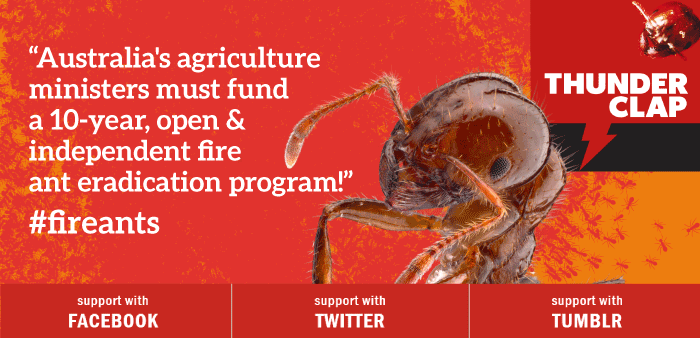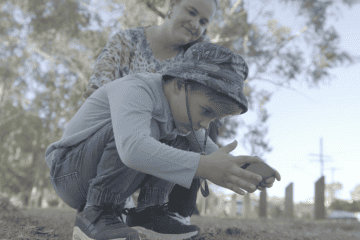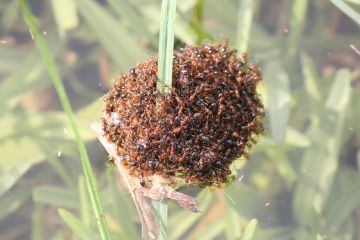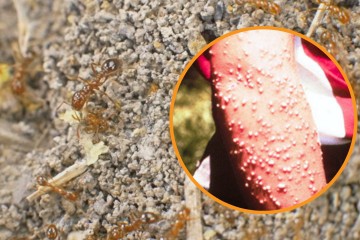Fire ants have been found in a new location in Australia. An infestation at Beerwah on Queensland’s Sunshine Coast was reported to Biosecurity Queensland by a keen-eyed property owner.
Confirmed by genetic tracing, this new infestation came from Brisbane and shows how easily and unpredictably fire ants can spread into new areas. Biosecurity Queensland acted quickly, alerting the public, running ant identification workshops and training sessions and mobilising community support for survey and control operations.
While this work is underway, the new find has broader implications. This infestation, about 70km north of the fire ant biosecurity zone, demonstrates controls put in place to prevent fire ant movements are insufficient. It is also a reminder that the window to do something about fire ants is closing rapidly.
The eradication program is ramping up, but we are still waiting for the meeting of Australia’s agriculture ministers on July 26 to provide a clear and unequivocal statement that fire ants are being taken seriously and that every state, territory and the federal government is ready to go the distance on a full eradication program.
We need you to add your voice to the call for action on fire ants by joining our social media Thunderclap!
[button link=”https://www.thunderclap.it/projects/59440-eradicate-fire-ants-now”]Create your Thunderclap now[/button]
Why fire ant eradication failed in the past
In the early part of last decade Australia’s fire ant eradication program suffered from short-term funding, only operating for five years at a time. Victory against the country’s fire ant infestations was declared too soon, and as funding was cut undiscovered fire ant nests required the work to start over again.
While the infestation area continued to grow, funding remained fixed and increasingly unstable. For the last four years, funding was approved one year at a time.
The program was secretive, closed to the community and cumbersome and many of the findings from past expert reviews were ignored.
Of course, it is easy to second guess these mistakes with the benefit of hindsight but how do we avoid making serious mistakes in the future?
We have developed a report on what we consider to be the seven essential governance recommendations for the national red imported fire ant eradication program. These are:
- Design an effective governance approach, including by consulting stakeholders and seeking the advice of experts
- Ensure structures and processes provide robust oversight and accountability to funders, industry and the community.
- Make sure decision-making is transparent so that stakeholders understand the rationale for decisions and can have confidence in the program.
- Develop a comprehensive eradication plan that includes techniques, costings, assumptions, milestones, roles, and responsibilities.
- Create an independent body to ensure the program is managed effectively.
- Involve experts from relevant fields for program design, advice and review.
- Make sure the community and industry is meaningfully engaged in the program.
We call this governance – it’s the detailed management structures and decision making about the most effective way to spend the fire ant eradication money.
Our last chance
The independent review of Australia’s fire ant eradication program released in December was very clear that the window of opportunity to eradicate fire ants is closing – the identification of fire ants on the Sunshine Coast is a terrible reminder of how easy it is for these ants to spread to new areas.
If Australia’s agriculture ministers do not set a clear course at their meeting later this month it will almost certainly mean we have missed our chance to eradicate this deadly invader.
The federal government, New South Wales and Victoria have all publicly committed to full funding of the fire ant program. Several states have told us off the record they will be supporting the program.
Many organisations have joined our statement of concern calling for a full, ten-year, $380 million eradication program, including the National Farmers Federation, AgForce, the Nature Conservation Council of NSW and the North Queensland Conservation Council.
Join our Thunderclap campaign
We now need you to support our last push by joining our Thunderclap campaign. You can sign up with your Twitter and Facebook account to participate in the social media blast >>
By joining us on Thunderclap, on the morning of July 26, when Australia’s agriculture ministers meet to decide the fate of the fire ant eradication program, a message will be automatically posted to your Facebook or Twitter accounts calling for full funding of the program.
We hope our Thunderclap campaign, along with last-minute lobbying efforts and media coverage, ensures Australia gets the fully funded, well-governed fire ant eradication campaign it deserves.
There is no aspect of our lives that will not be impacted by a fire ant infested Australia. This is the last opportunity for us to do something about it.





